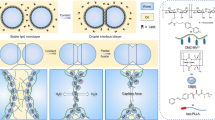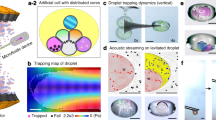Abstract
Aqueous droplets in oil that are coated with lipid monolayers and joined through interface bilayers1,2 are useful for biophysical measurements on membrane proteins2,3,4,5. Functional networks of droplets that can act as light sensors, batteries and electrical components can also be made by incorporating pumps, channels and pores into the bilayers2,6. These networks of droplets mimic simple tissues7, but so far have not been used in physiological environments because they have been constrained to a bulk oil phase. Here, we form structures called multisomes in which networks of aqueous droplets with defined compositions are encapsulated within small drops of oil in water. The encapsulated droplets adhere to one another and to the surface of the oil drop to form interface bilayers that allow them to communicate with each other and with the surrounding aqueous environment through membrane pores. The contents in the droplets can be released by changing the pH or temperature of the surrounding solution. The multicompartment framework of multisomes mimics a tissue7,8,9 and has potential applications in synthetic biology and medicine.
This is a preview of subscription content, access via your institution
Access options
Subscribe to this journal
Receive 12 print issues and online access
$259.00 per year
only $21.58 per issue
Buy this article
- Purchase on Springer Link
- Instant access to full article PDF
Prices may be subject to local taxes which are calculated during checkout





Similar content being viewed by others
References
Funakoshi, K., Suzuki, H. & Takeuchi, S. Lipid bilayer formation by contacting monolayers in a microfluidic device for membrane protein analysis. Anal. Chem. 78, 8169–8174 (2006).
Holden, M. A., Needham, D. & Bayley, H. Functional bionetworks from nanoliter water droplets. J. Am. Chem. Soc. 129, 8650–8655 (2007).
Heron, A. J., Thompson, J. R., Mason, A. E. & Wallace, M. I. Direct detection of membrane channels from gels using water-in-oil droplet bilayers. J. Am. Chem. Soc. 129, 16042–16047 (2007).
Syeda, R., Holden, M. A., Hwang, W. L. & Bayley, H. Screening blockers against a potassium channel with a droplet interface bilayer array. J. Am. Chem. Soc. 130, 15543–15548 (2008).
Heron, A. J., Thompson, J. R., Cronin, B., Bayley, H. & Wallace, M. I. Simultaneous measurement of ionic current and fluorescence from single protein pores. J. Am. Chem. Soc. 131, 1652–1653 (2009).
Maglia, G. et al. Droplet networks with incorporated protein diodes show collective properties. Nature Nanotech. 4, 437–440 (2009).
Woolfson, D. N. & Bromley, E. H. C. Synthetic biology. The Biochemist 19–25 (February 2011).
Channon, K., Bromley, E. H. C. & Woolfson, D. N. Synthetic biology through biomolecular design and engineering. Curr. Opin. Struct. Biol. 18, 491–498 (2008).
Solé, R. V., Munteanu, A., Rodriguez-Caso, C. & Macía, J. Synthetic protocell biology: from reproduction to computation. Phil. Trans. R. Soc. B 362, 1727–1739 (2007).
Walker, S. A., Kennedy, M. T. & Zasadzinski, J. A. Encapsulation of bilayer vesicles by self-assembly. Nature 387, 61–64 (1997).
Kim, S., Turker, M. S., Chi, E. Y., Sela, S. & Martin, G. M. Preparation of multivesicular liposomes. Biochim. Biophys. Acta Biomembranes 728, 339–348 (1983).
Yue, B. Y., Jackson, C. M., Taylor, J. A. G., Mingins, J. & Pethica, B. A. Phospholipid monolayers at non-polar oil/water interfaces. Part 1—Phase transitions in distearoyl-lecithin films at the n-heptane aqueous sodium chloride interface. J. Chem. Soc. Farad. Trans. I 72, 2685–2693 (1976).
Morisaku, T., Yui, H. & Sawada, T. Development of a new experimental system for monitoring biomembrane reactions: combination of laser spectroscopic techniques and biomembrane models formed at an oil/water interface. Anal. Sci. 20, 1605–1608 (2004).
Needham, D. & Haydon, D. A. Tensions and free energies of formation of ‘solventless’ lipid bilayers—measurement of high contact angles. Biophys. J. 41, 251–257 (1983).
Stoddart, D., Heron, A. J., Mikhailova, E., Maglia, G. & Bayley, H. Single-nucleotide discrimination in immobilized DNA oligonucleotides with a biological nanopore. Proc. Natl Acad. Sci. USA 106, 7702–7707 (2009).
Gu, L.-Q. & Bayley, H. Interaction of the noncovalent molecular adapter, β-cyclodextrin, with the staphylococcal α-hemolysin pore. Biophys. J. 79, 1967–1975 (2000).
Drummond, D. C., Zignani, M. & Leroux, J.-C. Current status of pH-sensitive liposomes in drug delivery. Prog. Lipid Res. 39, 409–460 (2000).
Hamilton, J. A. & Cistola, D. P. Transfer of oleic acid between albumin and phospholipid vesicles. Proc. Natl Acad. Sci. USA 83, 82–86 (1986).
Small, D. M., Cabral, D. J., Cistola, D. P., Parks, J. S. & Hamilton, J. A. The ionization behavior of fatty acids and bile acids in micelles and membranes. Hepatology 4, 77S–79S (1984).
Mills, J. K. & Needham, D. Lysolipid incorporation in dipalmitoylphosphatidylcholine bilayer membranes enhances the ion permeability and drug release rates at the membrane phase transition. Biochim. Biophys. Acta Biomembranes 1716, 77–96 (2005).
Nakagawa, S., Maeda, S. & Tsukihara, T. Structural and functional studies of gap junction channels. Curr. Opin. Struct. Biol. 20, 423–430 (2010).
Strambio-De-Castillia, C., Niepel, M. & Rout, M. P. The nuclear pore complex: bridging nuclear transport and gene regulation. Nature Rev. Mol. Cell Biol. 11, 490–501 (2010).
Needham, D. & Dewhirst, M. W. The development and testing of a new temperature-sensitive drug delivery system for the treatment of solid tumors. Adv. Drug Deliv. Rev. 53, 285–305 (2001).
Rautio, J. et al. Prodrugs: design and clinical applications. Nature Rev. Drug Discov. 7, 255–270 (2008).
Devine, D. V., Wong, K., Serrano, K., Chonn, A. & Cullis, P. R. Liposome-complement interactions in rat serum: implications for liposome survival studies. Biochim. Biophys. Acta Biomembranes 1191, 43–51 (1994).
Okushima, S., Nisisako, T., Torii, T. & Higuchi, T. Controlled production of monodisperse double emulsions by two-step droplet breakup in microfluidic devices. Langmuir 20, 9905–9908 (2004).
Chu, L.-Y., Utada, A. S., Shah, R. K., Kim, J.-W. & Weitz, D. A. Controllable monodisperse multiple emulsions. Angew. Chem. Int. Ed. 46, 8970–8974 (2007).
Seo, M., Paquet, C., Nie, Z., Xu, S. & Kumacheva, E. Microfluidic consecutive flow-focusing droplet generators. Soft Matter 3, 986–992 (2007).
Shum, H. C., Zhao, Y., Kim, S.-H. & Weitz, D. A. Multicompartment polymersomes from double emulsions. Angew. Chem. Int. Ed. 50, 1648–1651 (2011).
Debinski, W. & Tatter, S. B. Convection-enhanced delivery for the treatment of brain tumors. Exp. Rev. Neurother. 9, 1519–1527 (2009).
Larsen, C. et al. Intra-articular depot formulation principles: role in the management of postoperative pain and arthritic disorders. J. Pharm. Sci. 97, 4622–4654 (2008).
Cheley, S. et al. Spontaneous oligomerization of a staphylococcal α-hemolysin conformationally constrained by removal of residues that form the transmembrane β-barrel. Protein Eng. 10, 1433–1443 (1997).
Maglia, G., Heron, A. J., Stoddart, D., Japrung, D. & Bayley, H. Analysis of single nucleic acid molecules with protein nanopores. Methods Enzymol. 475, 591–623 (2010).
Maglia, G. et al. DNA strands from denatured duplexes are translocated through engineered protein nanopores at alkaline pH. Nano Lett. 9, 3831–3836 (2009).
Abràmoff, M. D., Magalhães, P. J. & Ram, S. J. Image processing with ImageJ. Biophoton. Int. 11, 36–42 (2004).
Acknowledgements
The authors thank E. Mikhailova for the αHL protein prepared by in vitro transcription/translation, and Q. Li for the αHL from S. aureus. The authors also thank M. Wallace for the loan of a microscope objective. This work was supported by grants from the National Institutes of Health and the European Commission's Seventh Framework Programme Revolutionary Approaches and Devices for Nucleic Acid Analysis Consortium. G.V. was supported by an Engineering and Physical Sciences Research Council Life Sciences Interface Doctoral Training Centre studentship.
Author information
Authors and Affiliations
Contributions
G.V., A.J.H. and H.B. planned the research. G.V. performed the experiments, data analysis and modelling. G.V. and H.B. wrote the paper.
Corresponding author
Ethics declarations
Competing interests
The authors declare no competing financial interests.
Supplementary information
Supplementary information
Supplementary information (PDF 2355 kb)
Rights and permissions
About this article
Cite this article
Villar, G., Heron, A. & Bayley, H. Formation of droplet networks that function in aqueous environments. Nature Nanotech 6, 803–808 (2011). https://doi.org/10.1038/nnano.2011.183
Received:
Accepted:
Published:
Issue Date:
DOI: https://doi.org/10.1038/nnano.2011.183
This article is cited by
-
Reconfigurable droplet networks
Nature Communications (2024)
-
4D Printing in Biomedical Engineering: a State-of-the-Art Review of Technologies, Biomaterials, and Application
Regenerative Engineering and Translational Medicine (2023)
-
Remote loading of minoxidil in nano-reservoirs leads to polymorphism and controlled release
Applied Nanoscience (2023)
-
Challenges and opportunities in achieving the full potential of droplet interface bilayers
Nature Chemistry (2022)
-
Building programmable multicompartment artificial cells incorporating remotely activated protein channels using microfluidics and acoustic levitation
Nature Communications (2022)



